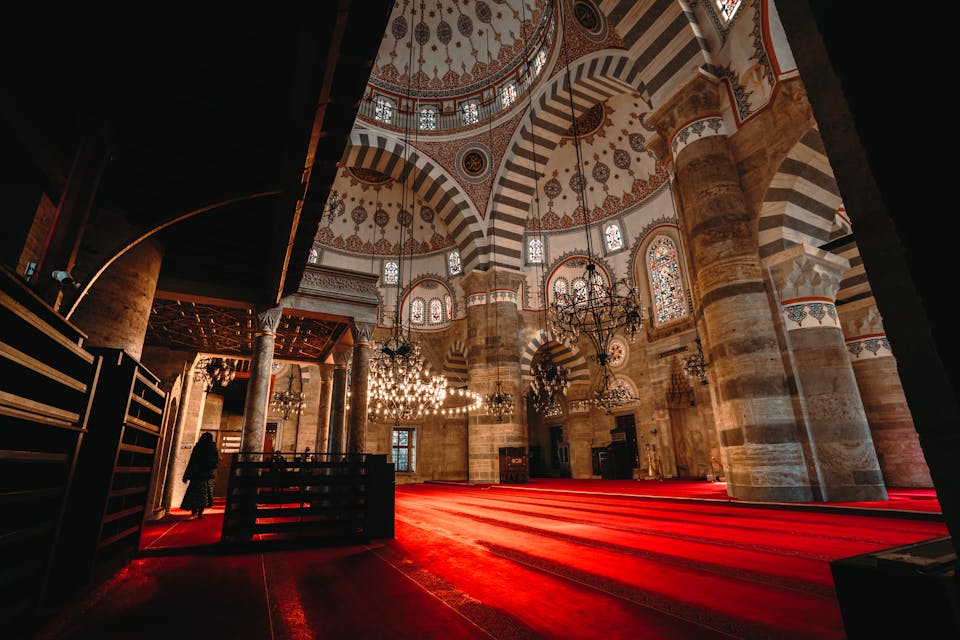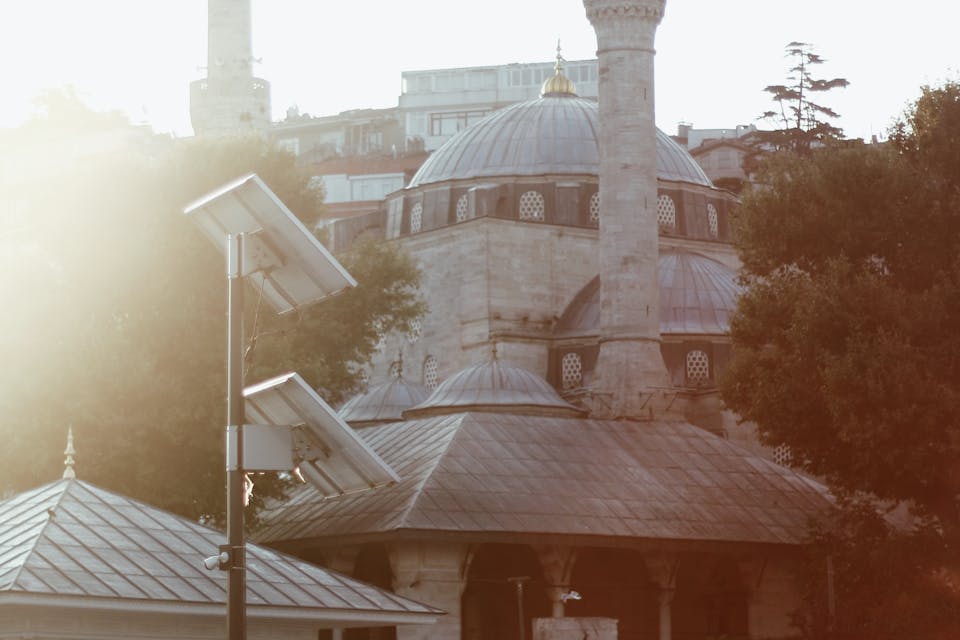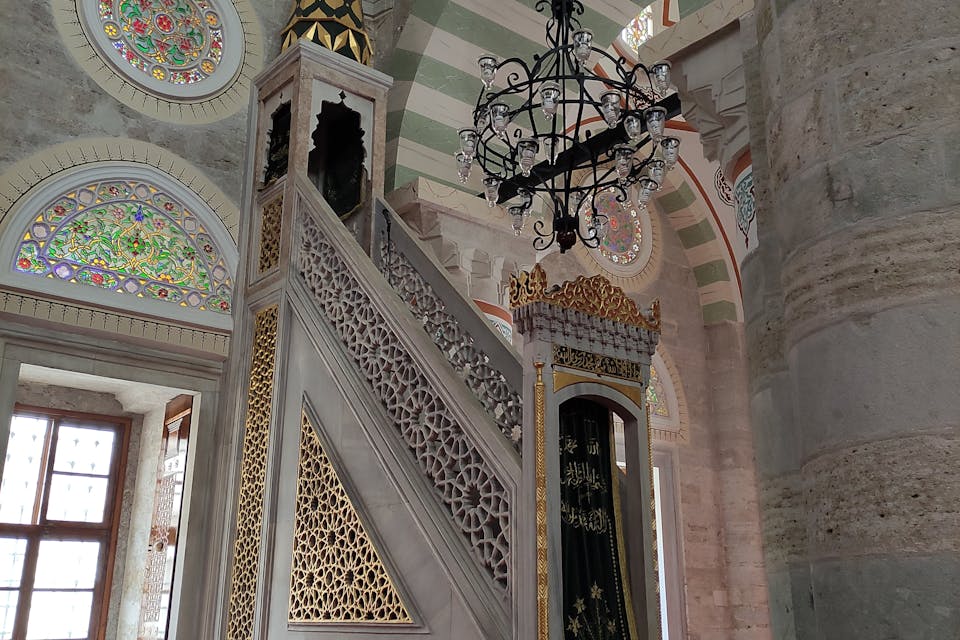The Mihrimah Sultan Mosque
1. What Is the History of the Mihrimah Sultan Mosque in Istanbul?
The Mihrimah Sultan Mosque, also known as the Mihrimah Sultan Camii, is a celebrated architectural jewel in Istanbul, emblematic of the Ottoman Empire’s grandeur. Completed between 1562 and 1565, this mosque is a tribute to Mihrimah Sultan, the beloved daughter of Suleiman the Magnificent, and a testament to her influence and patronage of the arts.
Situated in the historic Edirnekapi district, the mosque was strategically positioned to serve both spiritual and communal needs. The construction of this mosque was part of a broader urban development effort initiated by Mihrimah Sultan. As a prominent figure in the Ottoman court, Mihrimah Sultan used her influence to commission this mosque as a symbol of her piety and status.
Designed by the eminent Ottoman architect Mimar Sinan, the mosque is a quintessential example of Ottoman architecture at its peak. The mosque is not just a place of worship but a part of a larger complex that includes a madrasa, a library, and a hospice. This multifunctional design reflects the Ottoman approach to integrating religious, educational, and social services within a single complex.

2. How Does the Mihrimah Sultan Mosque Reflect Mimar Sinan's Architectural Style?
The Mihrimah Sultan Mosque is a profound reflection of Mimar Sinan's architectural style, characterized by elegance, innovation, and a deep understanding of spatial dynamics. Sinan, often hailed as the chief architect of the Ottoman Empire, integrated several of his signature design elements into this mosque:
2.1. Central Dome
The mosque features a grand central dome, which is a hallmark of Sinan's work. This dome, supported by semi-domes and arches, creates a spacious interior that is both visually stunning and functionally effective. The design ensures that the weight of the dome is evenly distributed, allowing for an expansive and unobstructed worship area.
2.2. Use of Light
Sinan’s innovative approach is evident in the mosque’s use of natural light. The extensive array of windows allows sunlight to filter through, casting a gentle glow across the prayer hall and enhancing the spiritual ambiance. This use of light not only illuminates the space but also emphasizes the intricate decorative elements that adorn the interior.
2.3. Elegant Minarets
Sinan's architectural genius is also reflected in the mosque's minarets, which are slender and elegant, contributing to the building’s vertical emphasis. This design choice adds to the mosque’s imposing presence and harmonizes with the surrounding urban landscape.

3. What Are the Unique Features of the Mihrimah Sultan Mosque?
The Mihrimah Sultan Mosque is distinguished by several unique features that set it apart from other Ottoman mosques:
3.1. Double Minarets
The mosque is notable for its two slender minarets, which are relatively rare in Sinan’s designs. These minarets not only enhance the mosque’s verticality but also contribute to its visual impact on the Istanbul skyline.
3.2. Expansive Dome
The central dome is a focal point of the mosque’s design, supported by an intricate network of semi-domes and arches. This configuration creates a sense of vastness and openness within the prayer hall.
3.3. Innovative Light Design
The mosque’s design incorporates an extensive array of windows, allowing natural light to flood the interior and create a serene and luminous atmosphere.
3.4. Artistic Decoration
The interior of the mosque is adorned with exquisite Ottoman calligraphy and Iznik tiles. The calligraphy features verses from the Quran and other religious texts, while the tiles display intricate geometric patterns and vibrant colors, reflecting the high level of artistic craftsmanship of the era.
3.5. Spacious Courtyard
The mosque is part of a larger complex that includes a well-designed courtyard, providing a tranquil space for reflection and interaction. The courtyard features a portico and is designed to integrate seamlessly with the mosque’s main prayer hall.
3.6. Functional Complex
Beyond the mosque itself, the complex includes a madrasa, library, and hospice, highlighting the multifunctional nature of Ottoman religious and educational institutions.

4. How Does the Design of Mihrimah Sultan Mosque Compare to Other Mosques by Mimar Sinan?
The Mihrimah Sultan Mosque is distinctive among Mimar Sinan’s works due to its scale and design approach. Compared to the Süleymaniye Mosque and the Selimiye Mosque, which are characterized by their grandeur and monumental proportions, the Mihrimah Sultan Mosque presents a more intimate and refined approach.
4.1. Balance Between Grandeur and Accessibility
The mosque’s design emphasizes a delicate balance between grandeur and accessibility. While the Süleymaniye Mosque features a vast central dome and extensive use of marble, the Mihrimah Sultan Mosque incorporates a more modest dome and lighter, more graceful architectural elements. This design choice reflects Sinan’s ability to tailor his architectural approach to the specific needs and preferences of his patrons.
4.2. Innovative Use of Light and Space
The Mihrimah Sultan Mosque also highlights Sinan’s innovative use of light and space. The strategic placement of windows and the use of semi-domes contribute to a bright and open interior, contrasting with the more enclosed and dimly lit spaces of some other mosques designed by Sinan.

5. What Are the Key Architectural Elements of the Mihrimah Sultan Mosque?
The Mihrimah Sultan Mosque features several key architectural elements that contribute to its significance:
5.1. Central Dome
The central dome is a prominent feature of the mosque, providing a focal point for the interior and contributing to its sense of grandeur.
5.2. Semi-Domes
Four semi-domes support the central dome, distributing its weight and enhancing the structural stability of the mosque.
5.3. Minarets
The mosque’s two slender minarets add vertical emphasis and elegance, enhancing its visibility and prominence within the cityscape.
5.4. Prayer Hall
The prayer hall is designed with a central axis that directs worshippers' attention towards the mihrab, the niche indicating the direction of Mecca.
5.5. Courtyard
The mosque complex includes a spacious courtyard with a portico, offering a transitional space between the mosque’s interior and the surrounding environment.
5.6. Decorative Elements
The mosque’s interior features elaborate calligraphic inscriptions and ceramic tiles, showcasing the artistic achievements of the Ottoman period and contributing to the overall aesthetic appeal.

6. What Can Visitors Expect When Touring the Mihrimah Sultan Mosque?
Visitors to the Mihrimah Sultan Mosque can expect a deeply immersive experience, marked by the mosque’s architectural splendor and historical significance. Upon arrival, the majestic minarets and grand entrance offer a dramatic introduction to the mosque’s beauty.
6.1. Interior Experience
Inside, the expansive prayer hall provides a serene environment for reflection and worship. The natural light filtering through the numerous windows creates a luminous and uplifting atmosphere, highlighting the mosque’s intricate tile work and calligraphic panels. These decorative elements, along with the mosque’s harmonious design, offer a glimpse into the artistic and architectural achievements of the Ottoman Empire.
6.2. Courtyard Experience
The mosque’s courtyard serves as a peaceful space for visitors to relax and appreciate the surrounding architecture. The courtyard’s design reflects traditional Ottoman elements and provides a transitional space between the mosque’s interior and the broader urban environment.
Overall, a visit to the Mihrimah Sultan Mosque offers valuable insights into Ottoman architectural mastery and the cultural heritage of Istanbul. Whether exploring the mosque’s historical significance, admiring its design features, or enjoying its tranquil environment, visitors will gain a deeper appreciation for the legacy of Mihrimah Sultan and the architectural genius of Mimar Sinan.